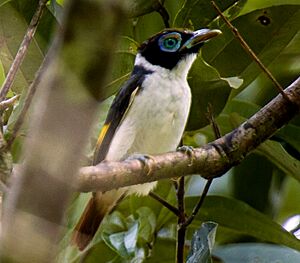Wattled broadbill facts for kids
Quick facts for kids Wattled broadbill |
|
|---|---|
 |
|
| Conservation status | |
| Scientific classification | |
| Genus: |
Sarcophanops
|
| Species: |
steerii
|
| Synonyms | |
|
Eurylaimus steerii |
|
The wattled broadbill is a super colorful bird found only in the Philippines. It's also called the Mindanao broadbill. This bird lives on islands like Mindanao, Basilan, Dinagat, and Siargao. It's easy to spot with its bright sky-blue "wattle" (a fleshy part on its face) and bill, plus a cool yellow patch on its wings!
These birds live in warm, wet places. Their homes include tropical lowland forests, mangrove forests near the sea, and tropical shrublands. Sadly, their homes are shrinking because of habitat loss.
Contents
Meet the Wattled Broadbill
The wattled broadbill is a very special bird. It belongs to the Eurylaimidae family. This bird was once thought to be the same as the Visayan broadbill. But scientists now know they are different species.
What Does It Look Like?
Wattled broadbills are quite unique. They are about 16 to 18 centimeters (6 to 7 inches) long. This makes them a bit bigger than the Visayan broadbill.
Male and female wattled broadbills look a little different. This is called being sexually dimorphic.
- Males have reddish-pink feathers on their bellies.
- Females have clean white feathers on their bellies.
You can tell them apart from the Visayan broadbill by a few things. The wattled broadbill has a white collar around its neck. It also has a bright yellow patch on its wings. These features make it stand out!
Types of Wattled Broadbills
Scientists recognize two main types, or subspecies, of the wattled broadbill:
- Sarcophanops steerii steerii: These birds live in central and eastern Mindanao. They are also found on Siargao and Dinagat Islands. Males of this type have darker red bellies. Sadly, there haven't been many recent sightings on Dinagat Islands.
- Sarcophanops steerii mayri: This type lives in the Zamboanga Peninsula and Basilan. These birds are a bit smaller. Their males have paler red bellies. It's possible they are no longer found on Basilan.
Where Do They Live?
Wattled broadbills love warm, wet forests. They live in tropical moist lowland forests. They prefer primary forests, which are old, untouched forests. They can also live in secondary forests that are well-grown. These birds usually stay in forests up to 750 meters (about 2,460 feet) above sea level.
These birds do not like it when their forest homes are damaged. They usually look for food in the lower parts of the forest. You might find them in the understory (the plants below the main trees) or close to the forest floor.
Protecting the Wattled Broadbill
The wattled broadbill is a vulnerable bird. This means it is at risk of disappearing forever. There are only an estimated 2,500 to 9,999 of these birds left.
Why Are They in Danger?
The biggest threat to these birds is the loss of their forest homes.
- Many lowland forests are being cut down. This is happening on all the islands where they live.
- Forests are being cut down legally and illegally.
- Forests are also being cleared to make farms. This often happens through a method called Slash-and-burn.
- Mining activities also destroy their habitat.
What Is Being Done?
Some areas where wattled broadbills live are protected. These include places like Mt. Apo, Pasonanca Natural Park, and Siargao Island Protected Landscape. However, the protection in these areas is sometimes not very strict.
To help these birds, scientists want to:
- Explore the remaining forests to find out exactly where the birds live.
- Figure out how many birds are left.
- Learn more about their daily lives and needs.
By understanding more about the wattled broadbill, we can better protect these amazing birds and their homes for the future.


